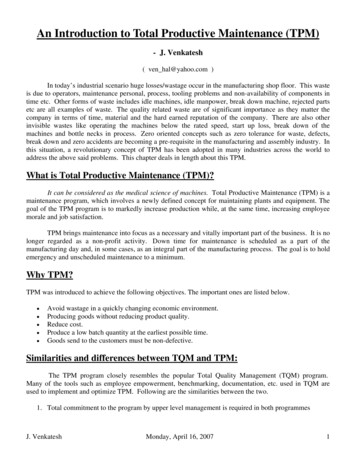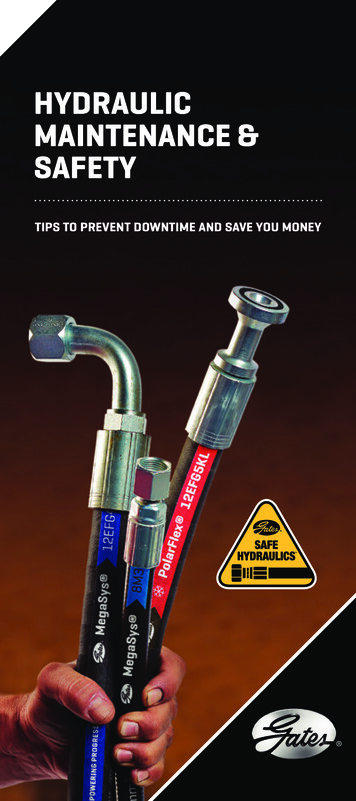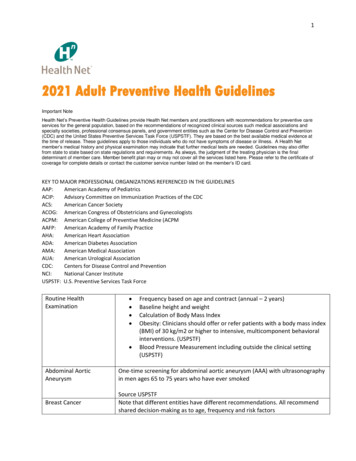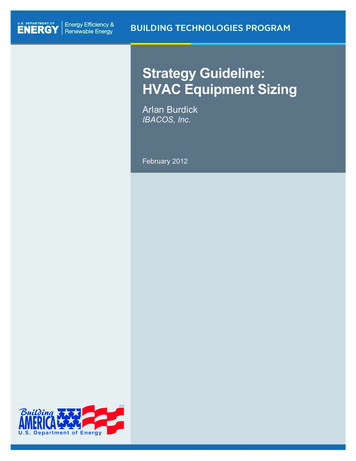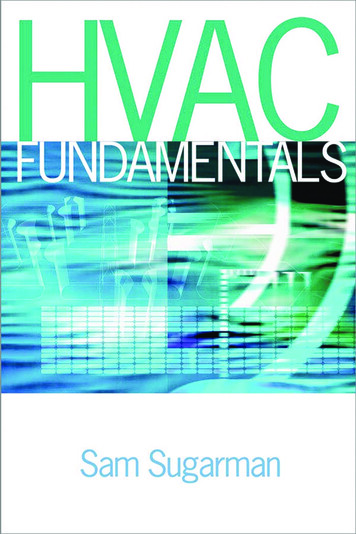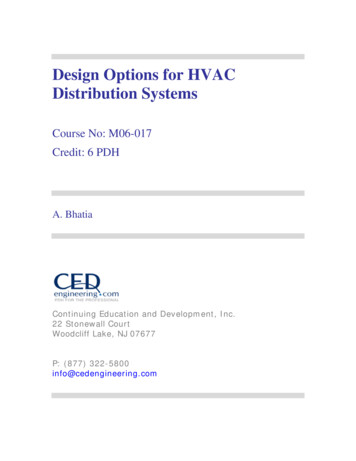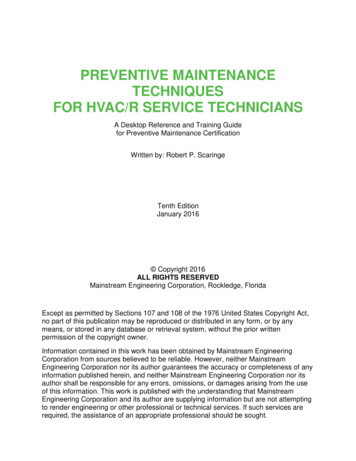
Transcription
PREVENTIVE MAINTENANCETECHNIQUESFOR HVAC/R SERVICE TECHNICIANSA Desktop Reference and Training Guidefor Preventive Maintenance CertificationWritten by: Robert P. ScaringeTenth EditionJanuary 2016 Copyright 2016ALL RIGHTS RESERVEDMainstream Engineering Corporation, Rockledge, FloridaExcept as permitted by Sections 107 and 108 of the 1976 United States Copyright Act,no part of this publication may be reproduced or distributed in any form, or by anymeans, or stored in any database or retrieval system, without the prior writtenpermission of the copyright owner.Information contained in this work has been obtained by Mainstream EngineeringCorporation from sources believed to be reliable. However, neither MainstreamEngineering Corporation nor its author guarantees the accuracy or completeness of anyinformation published herein, and neither Mainstream Engineering Corporation nor itsauthor shall be responsible for any errors, omissions, or damages arising from the useof this information. This work is published with the understanding that MainstreamEngineering Corporation and its author are supplying information but are not attemptingto render engineering or other professional or technical services. If such services arerequired, the assistance of an appropriate professional should be sought.
Table of ContentsTable of ContentsFiguresTablesPrefacePM Tech Examination InformationLevels of PM Tech CertificationApprentice PM TechJourneyman PM TechMaster PM TechDEFINITIONSSection 1: The Need for Certified PM TechniciansSection 2: Basic Vapor-Compression Refrigeration PrinciplesIntroductionThe Basic Vapor Compression CycleLeak Testing TechniquesRemoving MoistureEvacuation ProceduresDeep VacuumReplacement RefrigerantsRetrofittingLubricantsLubricant Change-OverRefrigerant ContaminationFlammability HazardsSDSSection 3: Sources of Potential FailureSection 4: Refrigerant Circuit Subsystem MaintenanceCheck Superheat and System ChargeAcid in SystemsUsing QwikCheck to Check for AcidFilter-Drier Types and LocationsInstructions for Using QwikShot Acid TreatmentMoisture in a SystemCheck for CorrosionSection 5: Air Side Subsystems MaintenanceCheck the Airflow Paths, Check for Mold and Clean the CoilsOutdoorsIndoors
Instructions for Using QwikClean Foaming Coil Cleaner on Evaporator CoilsInstructions for Using QwikClean Foaming Coil Cleaner on Condenser CoilsInstructions for Using PuraClean Filter SprayClean and Treat the Condensate Flow PathCheck the Indoor Fan Coil Unit for Air LeaksCheck for Free Spinning Operation of the Blower and Fan MotorsSection 6: Electrical Subsystem MaintenanceCheck that the Compressor Leads are Securely FastenedInstructions for Using QwikLug Check the ContactorCheck that the Contactor Points are CleanActivate the Contactor and Listen for Contactor Hum and/or VibrationCheck for Proper Starting of the CompressorCheck the Run Capacitor Under LoadCheck the Start CapacitorSection 7: Compressor Burnout Procedures
FiguresFigure 1. Certified PM Tech patchFigure 2. Standard Compressed Gas LabelsFigure 3. QwikCheck before acid testFigure 4. QwikCheck after acid test if acid is presentFigure 5. QwikShot being poured into QwikInjector for useFigure 6. QwikInjector connected inline for useFigure 7. Coils Before cleaning with QwikClean Foaming Coil CleanerFigure 8. Coils After cleaning with QwikClean Foaming Coil CleanerFigure 9. PuraClean Example of Treated vs. Untreated FilterFigure 10. Worn out capacitorFigure 11. QwikLug Figure 12. QwikSEER Wattsaver Figure 13. QwikCheck is yellow before acid test.Figure 14. QwikCheck is orange to red after acid test if acid is present.Figure 15. Red QwikCheck indicates acid is present.Figure 16. Yellow QwikCheck indicates no acid is present.Figure 17. Adding QwikShot to QwikInjector for useFigure 18. QwikShot injected into system using QwikInjector Figure 19. QwikClean Foaming Coil CleanerFigure 20. QwikLug instructionsFigure 21. Connection Terminals on X-13 Type MotorsFigure 22. Connection Terminals on ECM MotorsFigure 23. Diagram illustrating method of checking a capacitorFigure 24. Capacitor identifying mark
TablesTable 1. Pressure/Temperature Saturation Relationship for WaterTable 2. Refrigerant Blends Containing at Least One Flammable ComponentTable 3. Saturation Pressure-Temperature Chart for Common Refrigerants
PrefaceTable of ContentsThe information in this course is intended for educational purposes only. Proceduresdescribed are for use only by qualified air conditioning and refrigeration servicetechnicians who are already well versed in HVAC/R service techniques and who have avalid EPA Section 608 Certification. This training course is not a substitute for therequired EPA Section 608 certification or for any equipment Manufacturer's OperatorManual.Take safety precautions when using all HVAC equipment. Improper use of HVACequipment can cause explosion and serious personal injury. Always use extremecaution when working with refrigerants; hoses may contain liquid refrigerant underpressure. Use only approved refillable storage cylinders. Do not overfill any storagecylinder beyond its rated capacity. Always wear safety glasses. Protect the skin fromflash freezing. Never turn on any equipment if you do not understand its operation.Where procedures described in this manual differ from those of a specific equipmentmanufacturer, the equipment manufacturer's instructions should be followed.Mainstream Engineering Corporation assumes no liability for the use of informationpresented in this publication. This information is presented for educational purposesonly. Manufacturer's Operator Manuals must be consulted for the proper operation ofany piece of equipment.The content of this course is limited to information and service practices needed toeffectively extend the operating life of vapor-compression equipment, typically utilized inthe HVAC/R industry. This manual is not intended to teach fundamental air conditioningor refrigeration system techniques or safety practices. Likewise, this manual is notintended to teach safe refrigerant recovery or refrigerant handling techniques. Thismanual assumes the technician is well versed with these issues and possesses anEPA-Approved Section 608 certification.
PM Tech Examination InformationTable of ContentsThe PM Tech certification exams consist of 25 questions. Technicians can take the PMTech certification exam as many times as necessary (passing grade is 21 correct out ofthe 25 questions or 84%). The exams are open-book and technicians have a maximumof three hours to complete each exam. If you retake the exam, you will automatically begiven a different set of questions from the test bank.Three types of certification are available: Apprentice, Journeyman, and Master PMTech. Prior to obtaining any of Mainstream's PM Tech certifications, the technician musthave an EPA 608 certification from an EPA approved certifying agency, such asMainstream. Only 608 CERTIFIED TECHNICIANS can obtain a PM Tech certification.The PM tech certification exam is available on-line at www.epatest.com. You can TAKETHE EXAM ONLINE WHEN YOU ARE READY. The exam consists of 25 questions,which are related to preventive maintenance and proper use of QwikProducts toservice, repair and maintain air conditioning, refrigeration, and heat pump systems.Mainstream reserves the right to revoke the PM Tech certification given to anyindividual, at any time, and without prior notice, for excessive customer complaints,unethical or illegal service practices, failure to meet Mainstream's professionalrequirements, or any other reason deemed justifiable by Mainstream employees.Mainstream is under no legal obligation to disclose the reason for the termination.Levels of PM Tech CertificationTable of ContentsApprentice PM TechTable of ContentsThis certification requires EPA Section 608 certification from Mainstream or any otherEPA approved testing organization, and successful completion of the PM Tech examwith a score of 84% or better. Documentation to prove EPA certification by anyorganization other than Mainstream must be received and verified. For Mainstreamcertified 608 Technicians, we will automatically verify your EPA certification.
Journeyman PM TechTable of ContentsThis certification includes all the requirements of the Apprentice PM Tech (above) plusat least 5 years verifiable experience in the HVAC/R trades. Documentation tosubstantiate this experience is required.Master PM TechTable of ContentsThis certification includes all the requirements of the Apprentice PM Tech plus at least10 years verifiable experience in the HVAC/R trades. Documentation to substantiatethis experience is required.Figure 1. Certified PM Tech patchDEFINITIONSTable of ContentsAzeotropeA blend of two or more components whose equilibriumvapor phase and liquid phase compositions are thesame at a given pressure. In other words a blend thatbehaves as a pure refrigerant. R-5xx seriesrefrigerants such as R-502 are azeotropes.BiocideSubstance or chemical that kills organisms such asmolds
Dew PointIf the air is gradually cooled while maintaining themoisture content constant, the relative humidity willrise until it reaches 100%. This temperature, at whichthe moisture content in the air will saturate the air, iscalled the dew point. If the air is cooled further, someof the moisture will condense.Dry-Bulb TemperatureThe temperature of the air measured with a drythermocouple or thermometer with a dry bulb. The DryBulb and Wet-Bulb temperatures can be used togetherto determine relative humidity.EPAEnvironmental Protection AgencyExpansion DeviceThe Thermal Expansion Valve (TXV), ElectronicExpansion Valve (EXV), capillary tube, orifice plate orsimilar device, whose purpose is to drop the pressureof the refrigerant so as to lower the saturationtemperature of the refrigerant. Also known as theThrottling Device.FractionationThe separation of a liquid mixture into separate partsby the preferential evaporation of the more volatilecomponent. What occurs at a leak when a nonazeotropic blend has the more volatile componentevaporate away faster than the less volatilecomponents, causing a change in the blendformulation.FungiFungi are neither animals nor plants and are classifiedin a kingdom of their own. Fungi include molds, yeasts,mushrooms, and puffballs. In this document, the termsfungi and mold are used interchangeably. Moldsreproduce by making spores. Mold spores waft throughthe indoor and outdoor air continually. When moldspores land on a damp spot indoors, they may begingrowing and digesting whatever they are growing on.Molds can grow on virtually any organic substance,provided moisture and oxygen are present. It isestimated that more than 1.5 million species of fungiexist.HumidityThe water vapor mixed with air in the atmosphereHumidity RatioAlso known as Specific Humidity, the pounds of watercontained in a pound of dry air.HygroscopicSubstances that readily absorb moisture. POE oils are
hygroscopic.IsomerOne of a group of substances having the samecombination of elements but arranged spatially indifferent ways.MixtureA blend of two or more components that do not have afixed proportion to one another and that no matter howwell blended, still retain a separate existence (oil andwater for example).Non-Azeotropic RefrigerantAlso known as zeotropic, these are blends comprisingmultiple components of different volatility that, whenused as a refrigerant, change volumetric compositionand saturation temperatures as they evaporate (boil) orcondense at constant pressure. In other words, at aconstant pressure the boiling point temperature andcondensation point temperature (at the same pressure)are different. R-4xx series refrigerants such as R-404aare non-azeotropic refrigerants. Note that R-410a is anon-azeotropic refrigerant that exhibits near azeotropicbehavior. Non-azeotropic refrigerants must be chargedas a liquid to avoid fractionation during charging.Azeotropic refrigerants can be charged as either aliquid or vapor.Normal ChargeThe quantity of refrigerant within the appliance orappliance component when the appliance is operatingwith a full charge of refrigerant.Pressure RatioThe mathematical ratio of high-side pressure in PSIAdivided by the low-side pressure in PSIA.PSIAThe absolute pressure in pounds per square inch,where 0 PSIA corresponds to 29.9 inches of mercuryvacuum and 14.7 PSIA corresponds to 0 PSIG(pounds per square inch gauge).PSIGThe gauge pressure in pounds per square inch, where0 PSIG corresponds to atmospheric pressure (14.7PSIA). A positive PSIG value indicates the pressure inpounds per square inch above the ambient pressure.Relative HumidityThe ratio of weight of water in the air relative to themaximum weight of water that can be held in saturatedairVapor-Compression SystemThe general term referring to all air conditioners, heatpumps, refrigerators and chillers that all operate under
the principle of compressing a vapor to high pressureso that it will condense (at a higher temperature), thendropping the pressure to evaporate the refrigerant (toprovide cooling), followed by re-compressing therefrigerant to condense and complete the cycle.Wet-Bulb TemperatureThe temperature of the air measured with a wetthermocouple or thermometer with a wet bulb. TheDry-Bulb and Wet-Bulb temperatures can be usedtogether to determine relative humidity.Section 1:The Need for Certified PM TechniciansTable of ContentsIf you're suffering from a terrible pain, hopefully your doctor won't simply prescribe apain killer, but instead try to find the cause of the pain and treat it. Similarly, if your carmuffler fails, you hope the mechanic doesn't attempt to conceal the problem by turningup the volume on your radio. In these examples, the message is clear--treat theunderlying problem, not just the symptoms.The same message applies to problems with air conditioning and refrigeration systems.If you're changing a failed compressor without rectifying the underlying problem, orsimply recharging the system without fixing the leak, you're no better than the doctor orthe mechanic described above!As a business owner in the AC/Refrigeration field, don't you think equipment ownerswould pay more to fix the underlying problem and avoid future hassles? If you took thetime to fix the underlying cause of the problem, you can almost guarantee the customerwill call you back for future assistance, instead of finding another contractor in thephone book.One of your goals as a HVAC/R technician is to change your role from the business thatis only called on the hottest day of the year (when the system has failed), to the onewho is building a relationship with customers (and making more money and providingmore value along the way). In a perfect scenario, you want the equipment owner toappreciate the value of the service rendered, rather than only the cost of theservice.Many technicians reading this may be saying, "I deal with residential customers and allthey care about is lowest price!" This is not always true. Many of these same residentialcustomers also bring their vehicles to a dealership, rather than a local independent
mechanic, and pay much higher hourly labor rates. Oftentimes the equipment ownerdoes not see a difference in the quality of the service, so they merely select thelowest cost "supplier."As a Mainstream Certified PM Technician, you will be trained and tested to verify thatyou: Understand preventive maintenance techniques, Utilize the latest diagnostic and repair techniques, and Provide state of the art service.The focus of Mainstream's PM Tech certification program is to assure the equipmentowner that a Mainstream certified PM Tech can obtain optimum performance, reliability,and long life from the systems they service. As a Mainstream Certified PM Tech, yourname will be advertised by Mainstream as a professional who has successfully passeda higher level of certification and understands Preventive Maintenance procedures andmethodology.This manual is in a continual state of evolution and re-writing, partly because ofchanging technology and partly because of information feedback from technicians in thefield. If you believe sections of this manual require improvement, or that additionalinformation should be added, please write to us and we will consider your suggestionsfor future editions. In the past, we have received very useful comments and suggestionsfrom HVAC/R technicians in the field. To all those who have helped in the past, we owea sincere debt of gratitude. Suggestions on the improvement of this course or anyMainstream product are always welcome.Some material in this text has been extracted from Mainstream's EPA 608 manual.While we have attempted to minimize the duplication, we felt that technicians certifiedby other EPA programs may not have been exposed to this material, and therefore itwas important to include it. I apologize to those of you who have already seen thismaterial.For suggestions related to this course, please write to:Robert P. Scaringe, Ph.D., P.E.PM Tech Certification ProgramMainstream Engineering CorporationPines Industrial Center200 Yellow Place Rockledge, Florida, 32955orE-mail your comments to comments@PMTech.us.
Section 2:Basic Vapor-CompressionRefrigeration PrinciplesTable of ContentsIntroductionTable of ContentsIt is not the intent of this manual to teach basic refrigeration theory. However, a simplereview of some basic concepts is useful for describing the effects of non-condensablegases, moisture, and contaminants on the refrigeration system.The most basic vapor-compression refrigeration system consists of four majorcomponents: compressor, evaporator, condenser, and expansion device. Actualpractical hardware contains many other critical components for reliable, trouble-freeoperation, such as a control system, high-pressure and low-pressure safety controls,liquid receiver, accumulator, oil separator, crankcase pressure regulator, and so on. Thefour basic components are all that are needed to illustrate most of the points of thissection.The Basic Vapor Compression CycleTable of ContentsRefrigerant absorbs energy (provides cooling) as it evaporates, that is, as it boils andturns from liquid to vapor. For pure refrigerants (and azeotropic blends), if the refrigerantevaporates at a constant pressure, then evaporation (boiling) occurs at a constanttemperature (while both liquid and vapor are present). Likewise, refrigerant rejectsenergy (gives off heat) as it condenses from vapor to liquid. For pure refrigerants (andazeotropic blends), if the condensation occurs at a constant pressure, then thecondensation will occur at a constant temperature (until all the vapor has condensed toa liquid). Therefore, for evaporation or condensation, the temperature and pressure arerelated by the pressure/temperature saturation curve.NOTE: A point of confusion regarding pressure units appears to frequently occur. Whendiscussing pressure in PSI (pounds per square inch), PSIG means pounds per squareinch gauge and PSIA means pounds per square inch absolute. The two numbers differby approximately 15 PSI. A refrigeration gauge normally reads in units of PSIG, that is,in normal air it will read a pressure of zero. However, an absolute gauge would read a
pressure of about 14.7 PSIA in this same location. In refrigeration, we typically talkabout pressure above ambient in terms of PSI (with the ambient being at zero PSI so itwould be more accurate to refer to the pressure in PSIG). Likewise, we normally useinches of mercury to discuss vacuum levels with 29.9" mercury being a completevacuum (0 PSIA). Some of the new saturation charts for refrigerants are using theabsolute pressure instead of the combination of gauge pressure and vacuum in inchesof mercury. To convert PSIA to PSIG, simply subtract 14.7 (or round to 15) from thePSIA reading to get the PSIG reading. For example, a normal atmospheric pressure of14.7 PSIA is 0.0 PSIG, and 164.7 PSIA is 150 PSIG.As a simple rule of thumb to convert inches of mercury (the symbol for mercury is Hg) toPSIA, simply divide the value in inches of mercury by 2 and subtract it from 15 to get theapproximate PSIA reading. For example, 5" Hg is about 12.5 PSIA (actually it is 12.2PSIA), 10" Hg is about 10 PSIA (actually it is 9.8 PSIA), and finally 15" Hg is about 7.5PSIA (actually it is 7.3 PSIA).A brief discussion of the operating vapor-compression cycle is helpful to indicate otherpotential refrigeration problems in real systems. In the basic cycle, slightly subcooledrefrigerant leaves the condenser at high pressure, and the pressure is dropped via theexpansion device (capillary tube, TXV, etc.) before it enters the evaporator.NOTE: The amount of subcooling, which is reported in degrees, is the temperaturedifference between the saturation temperature of the refrigerant (at the condenserpressure) and the actual temperature of the refrigerant leaving the condenser.Refrigerant enters the evaporator as a two-phase mixture (liquid and vapor), andevaporates or boils at low temperature, absorbing heat. Slightly superheated refrigerantvapor exits the evaporator and enters the compressor where the pressure andtemperature are increased as the compressor compresses the refrigerant vapor, makingthe refrigerant even more superheated.NOTE: The amount of superheating, which is reported in degrees, is the temperaturedifference between the actual temperature of the refrigerant and the saturationtemperature of the refrigerant (at the same pressure). In the case of the evaporator, it isthe actual temperature of the refrigerant leaving the evaporator minus the saturationtemperature of the refrigerant (which is determined from the pressure of the refrigerantleaving the evaporator).The compressor discharge is the hottest point in the cycle, and the refrigerant has thegreatest superheat at this point. This refrigerant is cooled and condensed in thecondenser where heat is rejected, and the refrigerant is condensed to liquid. Refrigerantactually leaves the condenser slightly subcooled to ensure condensation has beencomplete. Any non-condensable vapors in the system will be unable to condense in thecondenser and will appear as gas bubbles in the condensed liquid stream. These noncondensables may collect in the condenser and displace refrigerant from the condenserheat exchanger, thereby reducing the effective surface area of the condenser. Noncondensables also lead to increased compressor temperatures and pressures, reducedcooling capacity, increased compressor pressure ratios, potential compressoroverheating, and finally, compressor motor burn-out.
Refrigerant moisture content is also a potential problem. Visual moisture indicatorsshould be replaced if they are washed out because moisture can result in expansionvalve freezing, increased acid formation, and reduced compressor life. Any water in thesystem will most likely freeze in the expansion valve because this is the point whererefrigerant is cooled by the evaporation occurring as a result of the sudden pressuredrop, and the expansion device also represents the smallest passageway in the overallsystem. This is the reason why liquid line filter-driers should be located just upstream ofthe expansion device.Leak Testing TechniquesTable of ContentsA vacuum test is not the best method of leak testing a system because it allows air, andthus moisture, to enter the system. The technician cannot determine from the vacuumwhere the leak is located, only that there is a leak. Also, when a vacuum is used to testfor leaks, it only proves that the system will not leak under a pressure difference of 14.7PSI. When the entire atmosphere is removed from a system, only the atmosphere'spressure is trying to get back into the system, therefore there is only a 14.7-PSIpressure difference.When checking for a leak using a vacuum, the technician is using a reverse pressure(the atmosphere trying to get into the system) of only 14.7 PSI. However, under normaloperating conditions, the system may be operating under an operating pressure ofseveral hundred PSIG, that is, 10 to 20 times the vacuum pressure difference.In addition, using a vacuum for leak checking may hide a leak. For example, if a pinsized hole is in a solder connection that has a flux buildup on it, the vacuum will tend topull the flux into the pinhole and may even hide it to the point that a deep vacuum canbe achieved. However, when pressure is applied to the system, the flux will blow out ofthe pinhole, and a leak will exist.The best leak-checking procedure is a standing pressure test using a pressure sourcethat will not change an appreciable amount with temperature changes. Nitrogen is agood gas to use. Never use compressed air or oxygen. Compressed air is full ofmoisture which is very difficult to remove and both air and oxygen can supportcombustion which can be very dangerous, since a fire or explosion is possible. If anelectronic leak detector is to be used along with this test, put a small amount of HFCrefrigerant in the system and bring the system pressure up to about 10 PSIG ofpressure (skip this step if an electronic leak detector is not being used). Then increasethe pressure, with nitrogen, up to the system's normal working pressure, as indicated onthe manufacturer's nameplate. Do not pressurize any system above the system'sworking pressure written on the equipment label. (Note that many large chillers andother low-pressure systems typically have a pressure relief valve set at 15 PSIG andare usually pressure tested to only 10 PSIG.) When the system has been pressurized,tap the gauge slightly to make sure the needle is free and record the pressure. If the
pressure falls over time, a leak exists. If a pressure drop is noted, remember thegauge manifold and connections may be leaking, and not the system. The smallerthe system, the shorter the standing time needed. For example, a small beverage coolermay need to stand for only an hour to be sure that the system is leak free, whereas a20-ton system may need to stand under pressure for 12 hours.Checking for leaks while the system is pressurized is preferred, because the leaks areeasier to detect. Always use a pressure regulator on the nitrogen cylinder.Mixtures of nitrogen and refrigerant that are used as leak-test gases are not subject tothe EPA venting prohibition, when used properly. A technician may not avoid recoveringrefrigerant by adding nitrogen to a charged system and then calling the mixture a leaktest gas mixture. Before nitrogen is added, the system MUST be evacuated to therequired level, any repairs must then be made and then the system should be chargedwith nitrogen to test for leaks (using a pressure decay test, for example). If a leak isdiscovered, then a small amount of the refrigerant normally being used in the systemcan be added to allow an electronic refrigerant leak detector to help identify the sourceof the leak. The leak-test gas should not be added to the nitrogen if an electronicrefrigerant leak detector is not going to be used. Failure to recover the refrigerant to theproper evacuation levels before adding the nitrogen-refrigerant leak-test mixture is aviolation of the EPA regulation and subject to fine.Another method of improving the odds of detecting very small leaks is to use afluorescent oil-soluble indicator (of course you must be sure the additive you areusing is compatible with the refrigerant and oil being used). The fluorescent dye makesthe oil residue at a small leak significantly more noticeable. This technique is useful onsmall, hard to find leaks, where the technicians can look for the leak the next time theyare servicing the unit. An ultraviolet lamp (or black light) is used to illuminate thefluorescent indicator. This approach is recommended for detecting very small leaks thatcould not be found with other means, unfortunately however, the UV light does not workwell in bright sunlight.An ultrasonic leak detector uses an ultrasonic detector to listen for leaking gas. Thismethod requires some advance knowledge of the location of the leak and a fairly lowbackground noise level. This technique is used with a nitrogen test gas. An ultrasonicleak detector can also be used with a noise source of a specific frequency placed insidethe equipment, and the detector tuned to the frequency.When all else fails, a helium leak detector may be the answer. Helium has a lowmolecular weight and helium will escape easily from a small leak. Refrigerants do notescape as easily due to their higher molecular weights. Helium leak detectors can findvery small leaks with amazing accuracy. However, they generally require a speciallytrained technician from a testing firm to operate the equipment.When the technician is convinced the system is leak-tight, both a standing pressuretest and a standing vacuum test are usually used as a final verification of the systemintegrity, cleanliness, and dryness. The vacuum test helps to assure that no trappedrefrigerant and/or water is in the system. In the standing pressure test described earlier,the system is pressurized to the normal operating pressure with nitrogen (using a
nitrogen bottle and regulator). The system is isolated from the nitrogen source and thepressure is recorded. Any drop in pressure after compensating for temperature changesindicates a leak.As a final system check before recharging the system, a standing vacuum test shouldbe performed. In a standing vacuum test, the system is evacuated to a deep vacuum.Because the quantity of gas trapped in the system is essentially zero, no compensationneeds to be made for temperature changes. An increase in pressure indicates a leakunless the pressure increases beyond 0 PSIG, which then indicates the presence oftrapped refrigerant in the system. The refrigerant continues to evaporate, causing thevapor press
the HVAC/R industry. This manual is not intended to teach fundamental air conditioning or refrigeration system techniques or safety practices. Likewise, this manual is not intended to teach safe refrigerant recovery or refrigerant handling techniques. This manual assumes the tec
